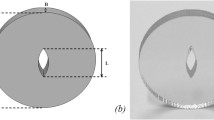Abstract
A 16-spark gap, modified schardin-type camera was constructed for use in dynamic photoelastic analysis of fracturing plastic plates. Using this camera system, dynamic photoelastic patterns in fracturing Homalite-100 plates, 3/8 in. × 10 in. × 15 in. with an effective test area of 10 in. × 10 in., loaded under fixed grip condition were recorded. The loading conditions were adjusted such that crack acceleration, branching, constant velocity, deceleration and arrest were achieved.
The Homalite-100 material was calibrated for static and dynamic properties of modulus of elasticity, Poisson's ratio, and stress-optical coefficient. For dynamic calibration, a Hopkinson bar setup was used to record the material response under constant-strain-rate loading conditions.
The precise location of the dynamic isochromatic patterns in relation to the crack tip was determined by a scanning microdensitometer. This information was then used to determine dynamic stress-intensity factors which were compared with corresponding static stress-intensity factors determined by the numerical method of direct stiffness. Although the response of the dynamic stress-intensity factor to increasing crack length was similar to the static stress-intensity-factor response, the dynamic values were approximately 40 percent higher than the static values for constant-velocity cracks. for decelerating cracks, the peak values of dynamic stress-intensity factors were 40 percent higher than the corresponding static values.
Similar content being viewed by others
References
Mott, N. F., “Fracture of Metals, Some Theoretical Considerations,” Engineering, 16–18 (January 2, 1948).
Roberts, D. K., and Wells, A. A., “The Velocity of Brittle Fracture,” Engineering, 820–821 (December 24, 1954).
Berry, J. P., “Some Kinetic Considerations of the Griffith Criterion for Fracture-I and II, Equations of Motion at Constant Force”,Jnl. Mech. and Phys. of Solids,8,194–206 and 207–216 (1951).
Yoffe, E. H., “The Moving Griffith Crack”,Phil. Mag., Ser. 7,42,739–750 (1951).
Broberg, B. K., “The Propagation of a Brittle Crack,”Arkiv for Phsik Band 18 nr 10, 159–192 (1960).
Baker, B. R., “Dynamic Stresses Created by a Moving Crack,” Jnl. Appl. Mech., 449–458 (September 1962).
Schardin, H., “Velocity Effects in Fracture,” Fracture, edited by B. L. Averbach, D. K. Felbeck, G. T. Hahn, and D. A. Thomas, John Wiley & Sons (1959).
Clark, A. B. J. andIrwin, G. R., “Crack Propagation Behaviors,”Experimental Mechanics 6 (6),321–330 (1966).
Wells, A. A. andPost, D., “The Dynamic Stress Distribution Surrounding a Running Crack—A Photoelastic Analysis”,Proc. SESA,16 (1),69–92 (1958).
Pratt, P. L. andStock, T. A. C., “The Distribution of Strain About a Running Crack,”Proc. Royal Society of London, A. 285, 73–82 (1964).
Kobayashi, A. S., Bradley, W. B., and Selby, R. A., “Transient Analysis in a Fracturing Epoxy Plate with a Central Crack,” Proc. Intl. Conf. on Fracture, Sendai, Japan (1965).
Dally, J. W. andRiley, W. F., “Stress Wave Propagation in a Half-Plane Due to a Transient Point Load,”Developments in Theoretical and Applied Mechanics,3,357–377 Pergamon Press,New York (1967).
Riley, W. F. andDally, J. W., “Recording Dynamic Fringe Patterns with a Cranz-Schardin System,”Experimental Mechanics,9(8)27N-33N (1969).
Clark, A. B. J. andSanford, R. J., “A Comparison of Static and Dynamic Properties of Photoelastic Materials,”Proc. SESA XX (2)148–151 (1963).
Beebe, W. M., “An Experimental Investigation of Dynamic Crack Propagation in Plastics and Metals,” California Institute of Technology Tech. Report No. AFML-TR-66-249 (November 1966).
Irwin, G. R., Discussion and Author's Closure of the Paper, “The Dynamic Stress Distribution Surrounding a Running Crack—A Photoelastic Analysis”,Proc. SESA, XVI (I),93–96 (1958).
Stock, T. A. C., “Stress Field Intensity Factors for Propagating Brittle Cracks,”Intl. Jnl. of Fracture,3 (2),121–130 (June1967).
Bradley, W. B. and Kobayashi, A. S., “Fracture Dynamics—A Photoelastic Investigation,” submitted for publication in Jnl. Engr. Fracture Mech.
Simon, B. J., “An Analysis of 2-Dimensional Fracture Mechanics Problems Using the Finite Element Method,” MS Thesis, University of Washington (March, 1969).
Author information
Authors and Affiliations
Additional information
W. B. Bradley was formerly a Research Associate at the University of Washington, Washington
The research reported in this technical report was made possible through support extended to the Department of Mechanical Engineering, University of Washington, by the Office of Naval Research under Contract Nonr-477 (39) NR 064 478. Reproduction in whole or in part is permitted for any purpose by the United States Government.
Rights and permissions
About this article
Cite this article
Bradley, W.B., Kobayashi, A.S. An investigation of propagating cracks by dynamic photoelasticity. Experimental Mechanics 10, 106–113 (1970). https://doi.org/10.1007/BF02325114
Issue Date:
DOI: https://doi.org/10.1007/BF02325114




